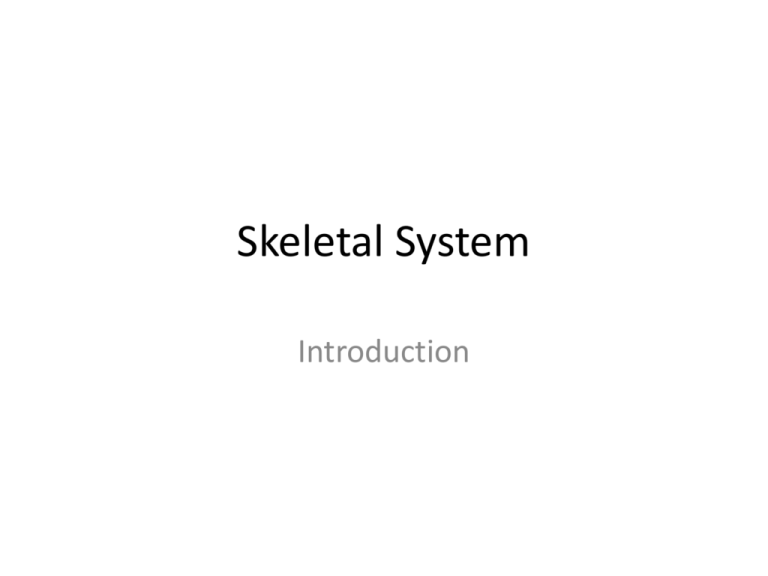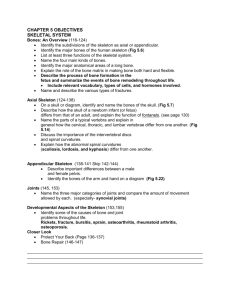
Skeletal System
Introduction
• The first correct illustrations of all bones was
done by Leonardo da Vinci.
• Primarily made of connective tissue.
©2006 by Thomson Delmar
Learning, a part of the
Thomson Corporation. ALL
2
The Functions of the Skeletal System
• Support of the body organs and tissues
• Protection of vital organs and soft tissues
• Assists in movement by providing levers for
muscles to pull on
• Manufacture blood cells (Hematopoiesis)
• Store mineral salts as the inorganic matrix of
bone and fat in yellow bone marrow.
©2006 by Thomson Delmar
Learning, a part of the
Thomson Corporation. ALL
3
The Skeletal System
• Parts of the skeletal system
– Bones (skeleton)
– Joints
– Cartilages
– Ligaments
• Divided into two divisions
– Axial skeleton
– Appendicular skeleton
The Axial and Appendicular Skeleton
• Axial: Forms the longitudinal part of the body
• Divided into three parts
– Skull
– Vertebral column
– Bony thorax
• Appendicular: Appendages (Everything else)
Axial and Appendicular Skeleton
Bones of the Human Body
• The adult skeleton has 206 bones
• Two basic types of bone tissue
– Compact bone
• Homogeneous
– Spongy bone
• Small needle-like
pieces of bone
• Many open spaces
Figure 5.2b
Spongy Bone
•
•
•
•
•
Aka ‘cancellous’ or ‘trabecular’ bone
Trabeculae - meshwork of bone
Spongy appearance created by trabeculae
Bone marrow fills spaces between trabeculae
Weaker than compact bone but lighter
©2006 by Thomson Delmar
Learning, a part of the
Thomson Corporation. ALL
8
Types of Bone Cells
• Osteocytes
– Mature bone cells
• Osteoblasts
– Bone-forming cells
• Osteoclasts
– Bone-destroying cells
– Break down bone matrix for remodeling and release
of calcium
• Bone remodeling is a process by both osteoblasts and
osteoclasts
The Classification of Bones
•
•
•
•
•
Long
Short
Flat
Irregular
Sesamoid – intermittent
occurrence, imbedded in
tendons, nonarticular
©2006 by Thomson Delmar Learning, a
part of the Thomson Corporation. ALL
RIGHTS RESERVED.
10
Classification of Bones on the Basis of
Shape
Figure 5.1
Bone Markings
(See textbook table 7.2 on p. 137)
• Processes - projections from the surface
– spine, condyle, tubercle, trochlea, trochanter,
crest, line, head, neck
• Fossae - depressions
– suture, foramen, meatus, sinus, sulcus
• Functions - muscle attachment, articulation,
passageways
©2006 by Thomson Delmar
Learning, a part of the
Thomson Corporation. ALL
12
Bone Marrow
• Red marrow
– hematopoiesis
– ribs, sternum, vertebrae, pelvis
• Yellow marrow
– fat storage
– shafts of long bones
©2006 by Thomson Delmar
Learning, a part of the
Thomson Corporation. ALL
13
Classification of Bones on the Basis of
Shape
Figure 5.1
Classification of Bones
Are you sure you need to write this down?
• Long bones
– Typically longer than wide
– Have a shaft with heads at both ends
– Contain mostly compact bone
• Examples: Femur, humerus
More self-evident classifications of bones.
• Flat bones
– Thin and flattened
– Usually curved
– Thin layers of compact bone around a layer of spongy
bone
• Examples: Skull, ribs, sternum
• Short bones
– Generally cube-shape
– Contain mostly spongy bone
• Examples: Carpals, tarsals






